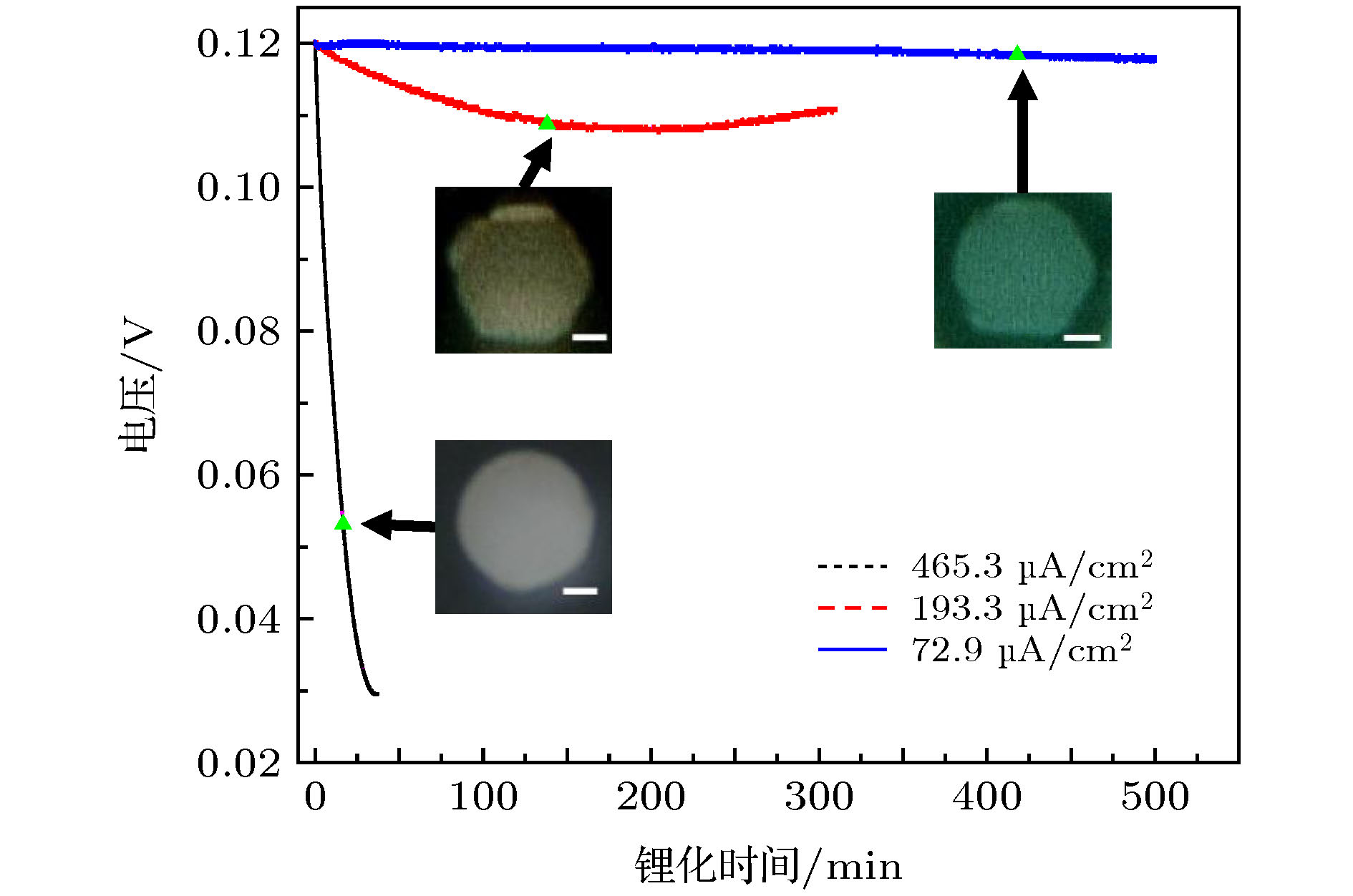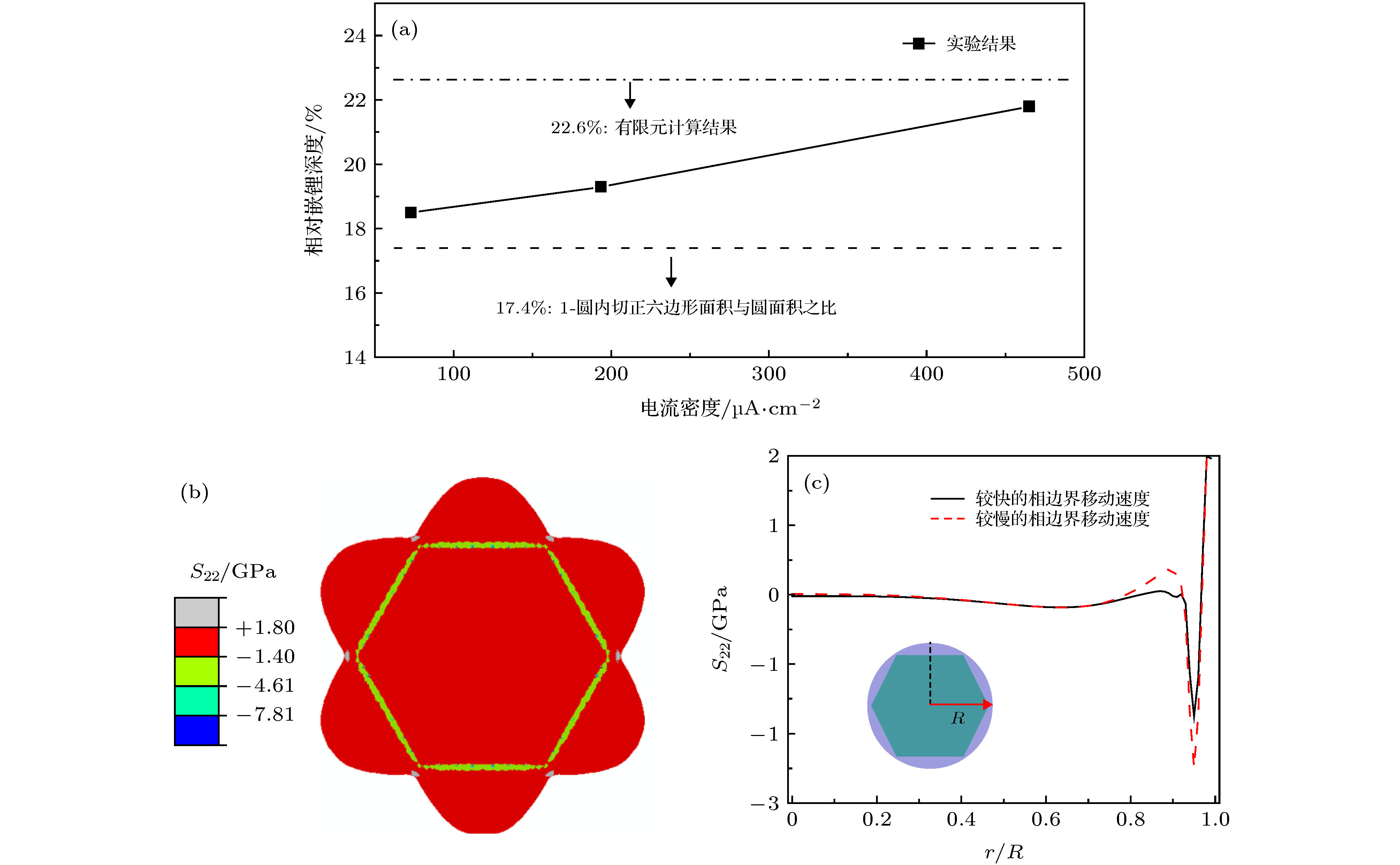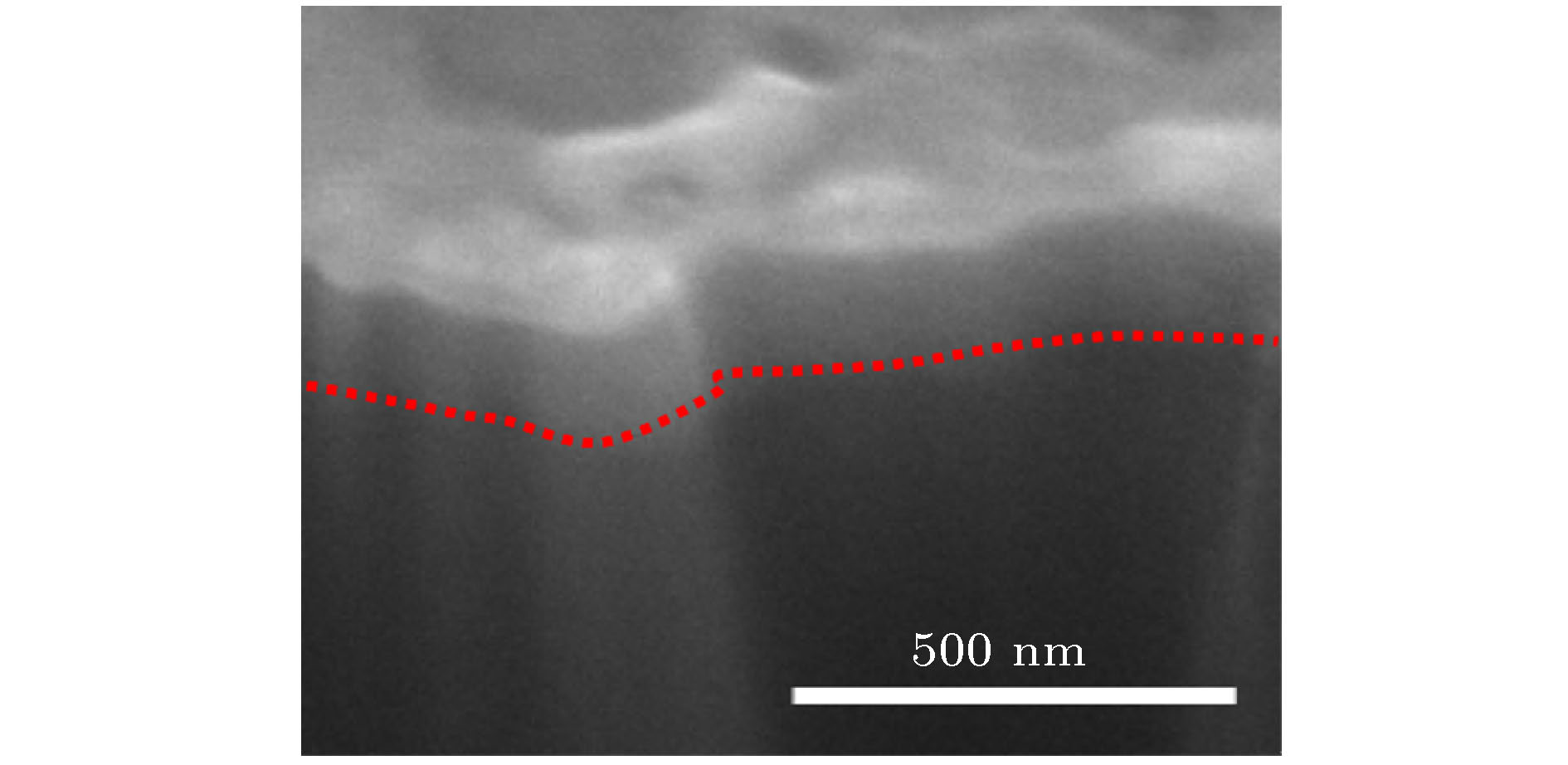-
高容量硅电极在脱/嵌锂过程中所发生的大体积变形、断裂行为会引起严重的力学衰减, 并导致电极的电化学性能退化. 这严重制约着硅电极材料在商业锂离子电池中的应用. 目前, 硅电极断裂行为的一些细节还未被彻底研究清楚. 为了进一步研究微米硅电极的断裂行为, 本文利用光学显微镜观测了单晶硅电极的形貌演化, 分析了不同电流密度下硅电极的断裂行为, 并重点研究了在不同电流密度下裂纹形成时硅电极的相对嵌锂深度. 结果表明, 电流密度越大, 硅电极断裂越严重. 但是在三种不同电流密度下, 裂纹形成时硅电极相对嵌锂深度差异不大(18%—22%). 这可能是由于微米硅电极各向异性变形所引起的局部应力集中在主导着断裂行为. 这些实验结果与有限元模型预测结果一致. 结合裂纹形成时锂化硅和晶体硅的界面位置以及力学模型, 讨论了裂纹形成时锂化硅层内部应力分布状态. 这些结果深化了对硅电极断裂行为的认识, 并为硅电极的设计和合适的脱/嵌锂速率选择提供一定的指导.The large volume change during lithiation/delithiation leads the silicon electrodes in lithium-ion batteries to severely degrade the mechanical performance and the silicon electrodes in lithium-ion batteries to further deteriorate electrochemical properties, which limits the commercial applications of silicon electrodes. After several year’s studies, the whole process of fracture for crystalline silicon anodes has been almost understood. However, the relationship between fracture behaviors and the lithiation depth has not been sufficiently studied. In this work, the in-situ observations of morphological changes (e.g., volume expansion, crack initiation, propagation, and debonding of lithiated silicon) during lithiation at the different current densities are reported for silicon micropillars fabricated by standard photolithography and a deep reactive ion etching process. Also, this work focuses on the relative depth of lithiation of silicon electrodes at the moment of crack initiation, which is one of the crucial parameters representing the utilization of active materials with no crack. The results show that the silicon micropillars are broken faster (i.e., crack initiation and pulverization in a shorter lithiation time) and more seriously at a large current density, exhibiting more prominent symmetry of morphology. However, the relative depths of lithiation at the different current densities have just a slight difference (i.e., 18%–22%), when cracks are initiated. Here in this work, a silicon micropillar fracture is confirmed by the optical observation, while the relative depth of lithiation is calculated according to the capacity data recorded by the charge/discharge battery test system. The small fluctuation of the relative depth of lithiation with the large wave of current density can be ascribed to the dominant role of local stress concentration caused by anisotropic volume change in fracture behavior, which is validated by the results obtained by the finite element model (i.e., the depth of lithiation predicted by numerical simulations is ~ 22.6%). Therefore, the relationship between fracture behavior and the lithiation kinetics is established, providing an effective strategy for estimating the utilization of active materials under crack-free operation. With the help of the theoretical mechanics model considering both volume change and concurrent movement of reaction front, the stress state in the lithiated silicon at the moment of crack initiation is given, showing the tensile hoop stress near the reaction front. Consequently, these results suggest that the fracture behaviors depend on the current density, but the position of crack initiation (i.e., the depth of lithiation with no crack) is unrelated to current density (at least in a relatively broad range) for large micron-sized crystalline silicon electrodes, thereby shedding light on the fracture mechanisms and the design of alloy anodes (e.g., size and structure) in lithium-ion batteries.
-
Keywords:
- lithium-ion battery /
- silicon electrode /
- fracture behavior /
- current density
[1] Kim U H, Ryu H H, Kim J H, Mücke R, Kaghazchi P, Yoon C S, Sun Y K 2019 Adv. Energy Mater. 9 1803902
 Google Scholar
Google Scholar
[2] Uxa D, Jerliu B, Hüger E, Dörrer L, Horisberger M, Stahn J, Schmidt H 2019 J. Phys. Chem. C 123 22027
 Google Scholar
Google Scholar
[3] Ryu J, Bok T, Kim S, Park S 2018 ChemNanoMat 4 319
 Google Scholar
Google Scholar
[4] Mukanova A, Jetybayeva A, Myung S, Kim S, Bakenov Z 2018 Mater. Today Energy 9 49
 Google Scholar
Google Scholar
[5] Li P, Zhao G, Zheng X, Xu X, Yao C, Sun W, Dou S X 2018 Energy Storage Mater. 15 422
 Google Scholar
Google Scholar
[6] Franco Gonzalez A, Yang N, Liu R 2017 J. Phys. Chem. C 121 27775
 Google Scholar
Google Scholar
[7] Zhang S 2017 npj Comput. Mater. 3 7
 Google Scholar
Google Scholar
[8] Jin Y, Zhu B, Lu Z, Liu N, Zhu J 2017 Adv. Energy Mater. 7 1700715
 Google Scholar
Google Scholar
[9] He Y, Yu X, Li G, Wang R, Li H, Wang Y, Gao H, Huang X 2012 J. Power Sources 216 131
 Google Scholar
Google Scholar
[10] Zhang X, Song W, Liu Z, Chen H, Li T, Wei Y, Fang D 2017 J. Mater. Chem. A 5 12793
 Google Scholar
Google Scholar
[11] Shi F, Song Z, Ross P N, Somorjai G A, Ritchie R O, Komvopoulos K 2016 Nat. Commun. 7 11886
 Google Scholar
Google Scholar
[12] Lee S W, Lee H, Ryu I, Nix W D, Gao H, Cui Y 2015 Nat. Commun. 6 7533
 Google Scholar
Google Scholar
[13] Lee S W, McDowell M T, Berla L A, Nix W D, Cui Y 2012 Proc. Natl. Acad. Sci. U.S.A. 109 4080
 Google Scholar
Google Scholar
[14] Pharr M, Zhao K, Wang X, Suo Z, Vlassak J J 2012 Nano Lett. 12 5039
 Google Scholar
Google Scholar
[15] McDowell M T, Ryu I, Lee S W, Wang C, Nix W D, Cui Y 2012 Adv. Mater. 24 6034
 Google Scholar
Google Scholar
[16] Ryu I, Choi J W, Cui Y, Nix W D 2011 J. Mech. Phys. Solids 59 1717
 Google Scholar
Google Scholar
[17] Lee S W, McDowell M T, Choi J W, Cui Y 2011 Nano Lett. 11 3034
 Google Scholar
Google Scholar
[18] Goldman J L, Long B R, Gewirth A A, Nuzzo R G 2011 Adv. Funct. Mater. 21 2412
 Google Scholar
Google Scholar
[19] Jia Z, Li T 2015 J. Power Sources 275 866
 Google Scholar
Google Scholar
[20] Zhao K, Pharr M, Wan Q, Wang W L, Kaxiras E, Vlassak J J, Suo Z 2012 J. Electrochem. Soc. 159 A238
 Google Scholar
Google Scholar
[21] Cui Z, Gao F, Qu J 2012 J. Mech. Phys. Solids 60 1280
 Google Scholar
Google Scholar
[22] Di Leo C V, Rejovitzky E, Anand L 2015 Int. J. Solids Struct. 67-68 283
 Google Scholar
Google Scholar
[23] 孙凤楠, 冯露, 卜家贺, 张静, 李林安, 王世斌 2019 物理学报 68 120201
 Google Scholar
Google Scholar
Sun F N, Feng L, Bu J H, Zhang J, Li L A, Wang S B 2019 Acta Phys. Sin. 68 120201
 Google Scholar
Google Scholar
[24] 彭劼扬, 王家海, 沈斌, 张静, 李浩亮, 孙昊明 2019 物理学报 68 090202
 Google Scholar
Google Scholar
Peng J Y, Wang J H, Shen B, Zhang J, Li H L, Sun H M 2019 Acta Phys. Sin. 68 090202
 Google Scholar
Google Scholar
[25] An Y, Wood B C, Ye J, Chiang Y, Wang Y M, Tang M, Jiang H 2015 Phys. Chem. Chem. Phys. 17 17718
 Google Scholar
Google Scholar
[26] Ryu I, Lee S W, Gao H, Cui Y, Nix W D 2014 J. Power Sources 255 274
 Google Scholar
Google Scholar
[27] Ye J C, An Y H, Heo T W, Biener M M, Nikolic R J, Tang M, Jiang H, Wang Y M 2014 J. Power Sources 248 447
 Google Scholar
Google Scholar
[28] Yang H, Fan F, Liang W, Guo X, Zhu T, Zhang S 2014 J. Mech. Phys. Solids 70 349
 Google Scholar
Google Scholar
[29] Tian R, Park S, King P J, Cunningham G, Coelho J, Nicolosi V, Coleman J N 2019 Nat. Commun. 10 1933
 Google Scholar
Google Scholar
[30] Pharr M, Suo Z, Vlassak J J 2014 J. Power Sources 270 569
 Google Scholar
Google Scholar
[31] Soni S K, Sheldon B W, Xiao X, Bower A F, Verbrugge M W 2012 J. Electrochem. Soc. 159 A1520
 Google Scholar
Google Scholar
[32] Boles S T, Thompson C V, Kraft O, Mönig R 2013 Appl. Phys. Lett. 103 263906
 Google Scholar
Google Scholar
[33] Berla L A, Lee S W, Cui Y, Nix W D 2015 J. Power Sources 273 41
 Google Scholar
Google Scholar
[34] Jia Z, Liu W K 2016 Appl. Phys. Lett. 109 163903
 Google Scholar
Google Scholar
-
图 6 (a) 不同电流密度下硅电极起裂时相对嵌锂深度; (b) 有限元模拟所得的应力云图; (c) 不同相边界移动速度下不同r/R (红色箭头标示)处径向应力分布
Fig. 6. (a) Relative lithiation depth for crack initiation of silicon electrodes at different current density; (b) hoop stress contour of Si micropillars obtained by finite element method; (c) hoop stress along the radial direction at different moving velocity of phase interfaces.
-
[1] Kim U H, Ryu H H, Kim J H, Mücke R, Kaghazchi P, Yoon C S, Sun Y K 2019 Adv. Energy Mater. 9 1803902
 Google Scholar
Google Scholar
[2] Uxa D, Jerliu B, Hüger E, Dörrer L, Horisberger M, Stahn J, Schmidt H 2019 J. Phys. Chem. C 123 22027
 Google Scholar
Google Scholar
[3] Ryu J, Bok T, Kim S, Park S 2018 ChemNanoMat 4 319
 Google Scholar
Google Scholar
[4] Mukanova A, Jetybayeva A, Myung S, Kim S, Bakenov Z 2018 Mater. Today Energy 9 49
 Google Scholar
Google Scholar
[5] Li P, Zhao G, Zheng X, Xu X, Yao C, Sun W, Dou S X 2018 Energy Storage Mater. 15 422
 Google Scholar
Google Scholar
[6] Franco Gonzalez A, Yang N, Liu R 2017 J. Phys. Chem. C 121 27775
 Google Scholar
Google Scholar
[7] Zhang S 2017 npj Comput. Mater. 3 7
 Google Scholar
Google Scholar
[8] Jin Y, Zhu B, Lu Z, Liu N, Zhu J 2017 Adv. Energy Mater. 7 1700715
 Google Scholar
Google Scholar
[9] He Y, Yu X, Li G, Wang R, Li H, Wang Y, Gao H, Huang X 2012 J. Power Sources 216 131
 Google Scholar
Google Scholar
[10] Zhang X, Song W, Liu Z, Chen H, Li T, Wei Y, Fang D 2017 J. Mater. Chem. A 5 12793
 Google Scholar
Google Scholar
[11] Shi F, Song Z, Ross P N, Somorjai G A, Ritchie R O, Komvopoulos K 2016 Nat. Commun. 7 11886
 Google Scholar
Google Scholar
[12] Lee S W, Lee H, Ryu I, Nix W D, Gao H, Cui Y 2015 Nat. Commun. 6 7533
 Google Scholar
Google Scholar
[13] Lee S W, McDowell M T, Berla L A, Nix W D, Cui Y 2012 Proc. Natl. Acad. Sci. U.S.A. 109 4080
 Google Scholar
Google Scholar
[14] Pharr M, Zhao K, Wang X, Suo Z, Vlassak J J 2012 Nano Lett. 12 5039
 Google Scholar
Google Scholar
[15] McDowell M T, Ryu I, Lee S W, Wang C, Nix W D, Cui Y 2012 Adv. Mater. 24 6034
 Google Scholar
Google Scholar
[16] Ryu I, Choi J W, Cui Y, Nix W D 2011 J. Mech. Phys. Solids 59 1717
 Google Scholar
Google Scholar
[17] Lee S W, McDowell M T, Choi J W, Cui Y 2011 Nano Lett. 11 3034
 Google Scholar
Google Scholar
[18] Goldman J L, Long B R, Gewirth A A, Nuzzo R G 2011 Adv. Funct. Mater. 21 2412
 Google Scholar
Google Scholar
[19] Jia Z, Li T 2015 J. Power Sources 275 866
 Google Scholar
Google Scholar
[20] Zhao K, Pharr M, Wan Q, Wang W L, Kaxiras E, Vlassak J J, Suo Z 2012 J. Electrochem. Soc. 159 A238
 Google Scholar
Google Scholar
[21] Cui Z, Gao F, Qu J 2012 J. Mech. Phys. Solids 60 1280
 Google Scholar
Google Scholar
[22] Di Leo C V, Rejovitzky E, Anand L 2015 Int. J. Solids Struct. 67-68 283
 Google Scholar
Google Scholar
[23] 孙凤楠, 冯露, 卜家贺, 张静, 李林安, 王世斌 2019 物理学报 68 120201
 Google Scholar
Google Scholar
Sun F N, Feng L, Bu J H, Zhang J, Li L A, Wang S B 2019 Acta Phys. Sin. 68 120201
 Google Scholar
Google Scholar
[24] 彭劼扬, 王家海, 沈斌, 张静, 李浩亮, 孙昊明 2019 物理学报 68 090202
 Google Scholar
Google Scholar
Peng J Y, Wang J H, Shen B, Zhang J, Li H L, Sun H M 2019 Acta Phys. Sin. 68 090202
 Google Scholar
Google Scholar
[25] An Y, Wood B C, Ye J, Chiang Y, Wang Y M, Tang M, Jiang H 2015 Phys. Chem. Chem. Phys. 17 17718
 Google Scholar
Google Scholar
[26] Ryu I, Lee S W, Gao H, Cui Y, Nix W D 2014 J. Power Sources 255 274
 Google Scholar
Google Scholar
[27] Ye J C, An Y H, Heo T W, Biener M M, Nikolic R J, Tang M, Jiang H, Wang Y M 2014 J. Power Sources 248 447
 Google Scholar
Google Scholar
[28] Yang H, Fan F, Liang W, Guo X, Zhu T, Zhang S 2014 J. Mech. Phys. Solids 70 349
 Google Scholar
Google Scholar
[29] Tian R, Park S, King P J, Cunningham G, Coelho J, Nicolosi V, Coleman J N 2019 Nat. Commun. 10 1933
 Google Scholar
Google Scholar
[30] Pharr M, Suo Z, Vlassak J J 2014 J. Power Sources 270 569
 Google Scholar
Google Scholar
[31] Soni S K, Sheldon B W, Xiao X, Bower A F, Verbrugge M W 2012 J. Electrochem. Soc. 159 A1520
 Google Scholar
Google Scholar
[32] Boles S T, Thompson C V, Kraft O, Mönig R 2013 Appl. Phys. Lett. 103 263906
 Google Scholar
Google Scholar
[33] Berla L A, Lee S W, Cui Y, Nix W D 2015 J. Power Sources 273 41
 Google Scholar
Google Scholar
[34] Jia Z, Liu W K 2016 Appl. Phys. Lett. 109 163903
 Google Scholar
Google Scholar
计量
- 文章访问数: 8828
- PDF下载量: 115
- 被引次数: 0














 下载:
下载:








